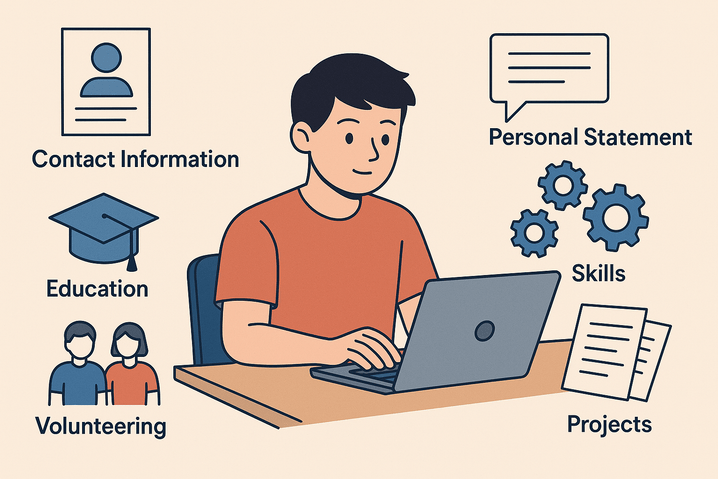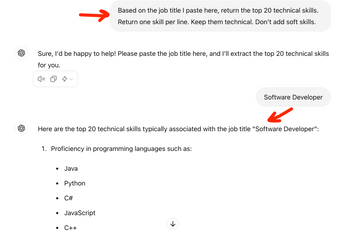
How to Write a CV with No Experience: Guide for Students & First-Time Job Seekers

Writing a CV when you have no formal work experience can feel overwhelming — but don’t worry, you have more to offer than you think. Whether you're a student, recent graduate, or changing careers, employers understand that not every candidate will come with years of professional experience. What matters most is how well you present your potential.
A CV with no experience should focus on your skills, education, achievements, and transferable qualities. By showcasing your strengths — such as communication, teamwork, reliability, and a willingness to learn — you can make a great impression, even without a traditional job history.
In this guide, we’ll walk you through exactly what to include, how to structure your CV, and tips to stand out — even if it’s your very first application. You'll also learn how to use tools like a CV builder or a template to create a professional, polished CV in minutes.
Let’s get started.
Who Needs a CV With No Experience?
Not everyone starts their job search with years of experience — and that’s completely normal. A CV with no experience is designed for people who may not have held a full-time job yet but still have valuable skills, education, and potential to offer.
You might need this kind of CV if you’re:
- A high school or college student applying for your first part-time job, internship, or summer position.
- A recent graduate entering the job market for the first time.
- A school leaver who’s not pursuing higher education but wants to start working.
- Changing careers and applying to a field where you don’t have direct experience yet.
- Returning to work after a gap or time away from formal employment.
- An international student or new immigrant looking to break into the job market in a new country.
In all these cases, your goal is to write a CV that focuses less on work history and more on your education, transferable skills, volunteering, projects, or extracurricular activities.
No experience doesn’t mean no value — it just means you need to highlight your potential and motivation in the right way.
What to Include in a CV With No Experience
When you’re writing a CV without work experience, the key is to focus on what you do have — not what you lack. Employers want to see that you’re capable, motivated, and willing to learn. Here’s what your CV should include:
-
Contact Information Start with your full name, phone number, email address, and (optionally) LinkedIn profile or personal website.
-
Personal Statement A short paragraph at the top of your CV summarizing who you are, what you’re looking for, and what you can bring to the role. Focus on your strengths, ambitions, and transferable skills.
-
Education Include your school, college, or university details. Mention qualifications, subjects studied, grades (if strong), and relevant coursework.
-
Skills Highlight both soft skills (like communication, teamwork, time management) and hard skills (such as Microsoft Office, coding, or language proficiency).
-
Volunteering or Internships If you’ve helped in community projects, school clubs, or done unpaid work, list it here. These experiences show initiative and can demonstrate job-relevant skills.
-
Extracurricular Activities Sports teams, debate clubs, student leadership, or creative projects all help show who you are outside the classroom.
-
Courses and Certifications Online learning platforms like Coursera or LinkedIn Learning are great sources of relevant training. Include any short courses you’ve completed.
-
Projects or Portfolios If you’ve worked on personal projects — like building a website, organizing an event, or starting a blog — mention them to show practical initiative.
-
References If possible, include a teacher, mentor, or supervisor who can vouch for your character and potential.
Every section should be tailored to the job you’re applying for. The goal is to show that even without job experience, you’re a great candidate who brings enthusiasm, learning ability, and relevant qualities to the table.
How to Structure Your CV With No Experience
A clear and logical structure is just as important as what you include. Recruiters often scan CVs in seconds, so it’s essential to present your information in a way that’s easy to follow. The most effective structure for a no-experience CV is reverse chronological order — where your most recent education, courses, or achievements appear first. This helps highlight your latest and most relevant accomplishments.
Use consistent section headings like Education, Skills, Projects, and Volunteering. Arrange them based on what’s most relevant to the job you're applying for. If you don’t have experience, put your education and skills near the top. Keep your contact information and personal statement at the very beginning.
Formatting Tips to Make Your CV Easy to Read
Great content can be overlooked if your CV is poorly formatted. Clean, professional design makes a big difference — especially when applying with no experience. Stick to these formatting best practices:
- Keep your CV to one page: Focus on the most relevant information and avoid long blocks of text.
- Use a readable font: Fonts like Arial, Calibri, or Helvetica at 10–12pt size are ideal.
- Use clear headings and white space: Headings should stand out, and spacing should separate sections for easy scanning.
- Avoid graphics or unusual layouts: Especially since many companies use Applicant Tracking Systems (ATS) that read text, not visuals.
- Stick to bullet points: They make your accomplishments and skills easier to digest at a glance.
A well-formatted CV not only looks more professional — it helps your strengths stand out quickly and clearly.
How to Write Each Section of Your CV (Without Experience)
Now that you know what to include, let’s break down how to write each section so it’s clear, effective, and tailored — even if you don’t have formal job experience.
1. Personal Statement
This is your introduction — 3–4 sentences that explain who you are, what you’re aiming for, and why you’re a good fit. Example:
Motivated and detail-oriented high school graduate with strong organizational skills and a passion for learning. Seeking an entry-level role in customer service where I can apply my communication and problem-solving abilities.
2. Education
List your most recent education first. Include the name of your school, dates attended, and key subjects or achievements. You can also mention coursework or projects relevant to the job. Example:
ABC High School, 2020–2024 GCSEs: 9 subjects including English (A), Maths (A), Science (B) Relevant Project: Created a presentation on sustainability that won a school award
3. Skills
Group your skills into categories (e.g., technical skills, soft skills). Use bullet points for clarity. Example:
- Strong written and verbal communication
- Basic knowledge of HTML and Canva
- Able to work in teams and independently
- Time management and multitasking
4. Volunteering / Work Experience
Even if it’s unpaid, this section shows initiative and real-world skills. Use bullet points to explain what you did and what you achieved. Example:
Volunteer – Local Animal Shelter
- Helped care for animals and maintain cleanliness
- Greeted visitors and answered questions
- Worked as part of a small team during weekend shifts
5. Extracurricular Activities
Activities like sports, school clubs, or creative hobbies show discipline, teamwork, and dedication. Example:
Debate Club Member
- Competed in local debate competitions
- Improved public speaking and critical thinking skills
6. Courses & Certifications
Online courses show initiative and continuous learning. List the course name and platform. Example:
Introduction to Digital Marketing – Coursera Basic Excel Skills for Data Entry – LinkedIn Learning
7. References
If you have space, include a teacher, tutor, or volunteer supervisor. Otherwise, simply write “References available on request.”
Each section should be concise, relevant, and targeted to the job or industry you’re applying for. Focus on results, actions, and skills — not job titles — and your CV will make a strong impact.
Tips to Make Your CV Stand Out (With No Experience)
Even without formal job experience, there are plenty of ways to make your CV stand out to employers. It’s all about presentation, relevance, and showing your potential clearly. Here are some proven tips:
1. Tailor Your CV to Every Job
Don’t send the same CV everywhere. Read the job description carefully and adjust your personal statement, skills, and examples to match what the employer is looking for.
2. Use a Clean, Professional Layout
Keep your CV simple, well-organized, and easy to read. Use clear headings, consistent fonts, and bullet points. Avoid clutter or excessive colors.
3. Focus on Transferable Skills
Think about what skills you've developed from school, volunteering, projects, or hobbies — like communication, teamwork, problem-solving, or leadership.
4. Use Strong Action Verbs
Start bullet points with active verbs like "organized," "created," "led," "supported," or "presented" to show initiative and ownership.
5. Highlight Achievements, Not Just Responsibilities
Wherever possible, show impact. For example, instead of saying “helped with fundraising,” say “raised £500 for local charity through school campaign.”
6. Include Keywords from the Job Description
Many employers use Applicant Tracking Systems (ATS) to automatically scan CVs and filter candidates based on relevance. If your CV doesn’t include the right keywords, it might never reach a human. Make sure you’re using the same terms and skills mentioned in the job ad to improve your chances of being shortlisted.
7. Mention Projects or Portfolios
If you’ve built something — a personal blog, a school project, a short film, or an art portfolio — include it. It shows initiative, creativity, and relevant interest.
8. Keep It to One Page
Unless you have a lot of relevant experience or training, stick to a single page. It’s easier to read and more focused.
A no-experience CV doesn’t have to be a “blank” CV. With the right strategy and attention to detail, you can create a document that reflects your potential, personality, and readiness to work.
Other Ways to Show Experience on Your CV
Even without formal employment, you’ve likely worked on projects that demonstrate valuable skills. These experiences can be just as relevant as paid jobs if they show initiative, responsibility, or job-related abilities.
School Projects Class assignments, group presentations, or research projects can highlight teamwork, time management, problem-solving, and subject-specific knowledge — especially if they relate to the role you're applying for.
Freelance Work If you’ve done any freelance work — like tutoring, graphic design, writing, or helping someone build a website — include it. Even short-term or informal gigs show real-world skills and reliability.
Course-Based Assignments Online courses often include final projects, case studies, or simulations. If you’ve completed a course that required applying your skills in a practical way, describe the assignment and what you accomplished.
These types of experience show that you’re proactive, capable of independent work, and already applying what you’ve learned — which is exactly what employers want to see in a first-time applicant.
Use Action Verbs to Strengthen Your CV
The way you describe your experience can be just as important as the experience itself. Using action verbs at the start of each bullet point makes your writing more direct, confident, and impactful.
Instead of saying “Responsible for helping with events,” say “Organized weekly student events with 50+ attendees.” Action verbs bring your skills to life and show ownership of your contributions.
Here’s a list of action verbs you can use to enhance different sections of your CV:
For Projects and Volunteering
- Organized
- Coordinated
- Participated
- Delivered
- Contributed
For Skills and Problem Solving
- Analyzed
- Researched
- Created
- Solved
- Improved
For Communication and Leadership
- Presented
- Led
- Collaborated
- Advised
- Facilitated
For Creativity and Technical Skills
- Designed
- Built
- Programmed
- Edited
- Produced
Use these verbs to begin each bullet point in your CV. They help demonstrate your impact, make your CV more readable, and give hiring managers a clearer picture of what you’ve accomplished — even without formal work experience.
Include a Cover Letter With Your CV
When you’re applying for jobs without experience, a cover letter becomes especially important. It’s your chance to speak directly to the employer, explain your motivation, and highlight what makes you a great fit — even if you don’t have a job history yet.
Use the cover letter to share why you’re excited about the position or the company. This shows genuine interest and helps you stand out from generic applications.
As a student team leader during a school project, I developed strong communication and problem-solving skills that I’m eager to bring to a customer-facing role.
Employers value attitude just as much as experience. Emphasize that you’re eager to train, grow, and contribute. While you may not have direct experience, showing that you’re highly motivated to learn and make an impact can go a long way.
Aim for about 3–4 short paragraphs. Address the hiring manager by name if possible, and write in a professional but friendly tone. Adding a personalized cover letter to your CV shows effort, confidence, and clarity — and it can make all the difference when applying with no experience.
Use a CV Builder Tool
If you’re not sure where to start or how to format your CV, using a CV builder can save time and help you create a polished, professional document — even with no experience. A good CV builder provides ready-made templates, structured layouts, and helpful tips as you go.
CV builders are especially useful if you:
- Don’t have design experience and want your CV to look clean and modern
- Want to avoid formatting issues with margins, spacing, or fonts
- Need guidance on how to word each section, especially without a work history
- Prefer a faster, more efficient way to create multiple tailored versions of your CV
Many tools, including AI-powered CV builders, can suggest phrases and skills based on the job you’re applying for. This helps ensure your CV aligns with what employers are looking for, increasing your chances of getting noticed.
- Who Needs a CV With No Experience?
- What to Include in a CV With No Experience
- How to Structure Your CV With No Experience
- Formatting Tips to Make Your CV Easy to Read
- How to Write Each Section of Your CV (Without Experience)
- Tips to Make Your CV Stand Out (With No Experience)
- Other Ways to Show Experience on Your CV
- Use Action Verbs to Strengthen Your CV
- Include a Cover Letter With Your CV
- Use a CV Builder Tool

Written By
Madison Norton
VP Marketing & Resume Expert
Madison is the VP Marketing and General Manager at VisualCV. He's a seasoned marketing leader, resume writing and career marketing expert and now helping people grow their own career marketing strategies to build a career they love.

Get the most out of your job search by making sure your professional CV format is perfect.
February 11, 2025
Read Post

Community Success Manager & CV Writing Expert

Over 50+ professional cover letter examples to include with your job application in 2025 - easy to create a custom cover letter for each application.
January 2, 2025
Read Post

VP Marketing & Resume Expert


VP Marketing & Resume Expert
Copyright ©2025 Workstory Inc.